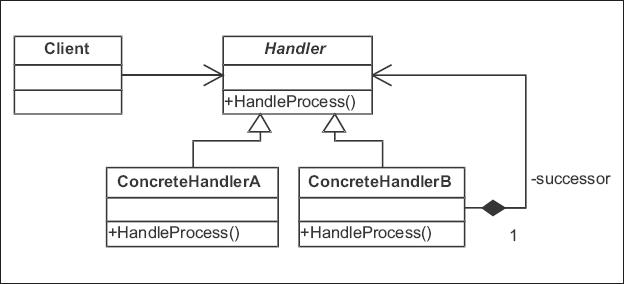What Is a Chain of Responsibility Pattern
The Chain of Responsibility pattern performs a lot like it sounds. If you have a group of classes that are all interdependent on each other and each performs a particular piece of processing, this pattern is a very useful tool. It makes sure each member in a chain controls when and to what class it hands its processing to. The pattern controls the code flow by using inheritance and by allowing instances of its predecessors to be loaded one inside the other, forming in effect a chain of classes that hand off to the next class in the chain at the end of its turn.
The Chain of Responsibility pattern has a single main component: the Handler. The handler object encapsulates the entire chain of handler instances inside each other instance. In other words, the first link in the chain contains the next and that link contains each consecutive link. As you move through each link’s process and that process finishes, it automatically checks for the existence of the next consecutive link and calls the process of that next link. This can happen no matter which level of link in the chain you call and will continue down the chain until the chain ends.

Comparison to Similar Patterns
Depending on whether you wish to provide a set operational cycle or you want to change that cycle on the fly might influence your decision to use the Chain of Responsibility pattern or a Command pattern. The Command pattern holds an order of operations in its command queue, but allows ad-hoc calls to any operation desired via the command object. In contrast, the Chain of Responsibility pattern more rigidly defines the order of operations. Your particular usage depends on which is more suitable to your needs. The Chain of Responsibility also is like the Composite pattern in that parsing through the class chain is like moving through each collection class in the composite. Both patterns move through class methods in a serial fashion.
What We Have Learned
The Chain of Responsibility pattern seems to be quite a good way to link classes that have interdependence on each other in an order of operations. You could implement the pattern in an approval cycle, where people needed to approve specific requests in turn. You could use it to determine an order of operations for executing nearly any kind of code. This order can easily be changed at run time or in different code instances, depending on the need.
The Chain of Responsibility pattern performs a lot like it sounds. If you have a group of classes that are all interdependent on each other and each performs a particular piece of processing, this pattern is a very useful tool. It makes sure each member in a chain controls when and to what class it hands its processing to. The pattern controls the code flow by using inheritance and by allowing instances of its predecessors to be loaded one inside the other, forming in effect a chain of classes that hand off to the next class in the chain at the end of its turn.
The Chain of Responsibility pattern has a single main component: the Handler. The handler object encapsulates the entire chain of handler instances inside each other instance. In other words, the first link in the chain contains the next and that link contains each consecutive link. As you move through each link’s process and that process finishes, it automatically checks for the existence of the next consecutive link and calls the process of that next link. This can happen no matter which level of link in the chain you call and will continue down the chain until the chain ends.

Comparison to Similar Patterns
Depending on whether you wish to provide a set operational cycle or you want to change that cycle on the fly might influence your decision to use the Chain of Responsibility pattern or a Command pattern. The Command pattern holds an order of operations in its command queue, but allows ad-hoc calls to any operation desired via the command object. In contrast, the Chain of Responsibility pattern more rigidly defines the order of operations. Your particular usage depends on which is more suitable to your needs. The Chain of Responsibility also is like the Composite pattern in that parsing through the class chain is like moving through each collection class in the composite. Both patterns move through class methods in a serial fashion.
What We Have Learned
The Chain of Responsibility pattern seems to be quite a good way to link classes that have interdependence on each other in an order of operations. You could implement the pattern in an approval cycle, where people needed to approve specific requests in turn. You could use it to determine an order of operations for executing nearly any kind of code. This order can easily be changed at run time or in different code instances, depending on the need.





















 456
456

 被折叠的 条评论
为什么被折叠?
被折叠的 条评论
为什么被折叠?








